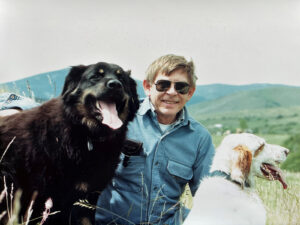
Friends of the Clark Fork River remember Phil Tourangeau as an inspiring public interest scientist whose life and career created positive impacts for generations to come.
Phil arrived at the University of Montana in the 1970’s to pursue a PhD with UM Professor Clancy Gordon, co-founder of UM’s Environmental Studies program, director of UM’s Environmental Science Lab, and a pioneer in public interest science. Like his mentor, Phil focused his research on the impacts of industrial air pollution, serving as an expert witness or scientific resource in landmark lawsuits that tied industrial air emissions to the economic impacts on forests and agricultural land.
When Clancy died in 1981, Phil became Acting Director of the lab – now renamed the Clancy Gordon Environmental Science Laboratory. He took on the job of finishing the lab’s many projects and initiated new research on the sediments of Milltown Reservoir, where the discovery of arsenic in the sediments and groundwater wells led to the creation of the Milltown Reservoir Sediments Operable Unit of the newly designated Clark Fork River Superfund Complex. As a result, Phil became a key player in the decades-long efforts to reclaim the Clark Fork watershed. After leaving UM, Phil worked as a staff scientist for the Clark Fork Coalition (then known as the Clark Fork Pend d’Oreille Coalition). He served as an advisor to the Milltown Superfund Site Redevelopment Working Group, representing the Confederated Salish and Kootenai Tribes. He shared information with the public and provided commentary on numerous technical documents.
Phil’s colleagues reported that he chose to work for organizations “whose interests aligned with the river.” He was also a fierce advocate for the Confederated Salish and Kootenai Tribes during the Superfund cleanup. When working with the Upper Clark Fork River Basin Remediation and Restoration Advisory Council, he fought to ensure tribal voices and values were kept at the forefront, working diligently to resolve conflicts between CSKT and the Advisory Council. For well over a decade, Phil served as a Natural Resources Damages Coordinator for CSKT, and then for a year for the National Park Service’s Grant Kohrs Historic Ranch on the river.
Due to his efforts to finish Clancy Gordon’s projects and the many battles he fought for the Clark Fork, Phil was never able to complete his PhD. And due to his untimely death in 2006, he did not live to see the removal of Milltown Dam and creation of Milltown State Park. Instead, thousands of local citizens and visitors, along with the river’s wildlife would regain a healthy watershed and benefit from his decades of work. The Missoula Conservation Roundtable awarded him their Lifetime Conservation Award in 2007 – the second ever awarded. As his former colleagues stated, Phil was “definitely a big hero for the [Clark Fork] river” and “embodied the spirit of the Superfund law in the Basin.”
By Kalle Fox and Sally Johnson
The Missoula Conservation Roundtable gratefully acknowledges generous contributions to our website design. Our logo was created by Kate Davis, Raptors of the Rockies; Brian Christianson contributed the photographs for page headers Brian Christianson Photography
Website created by Irestone Web Design
